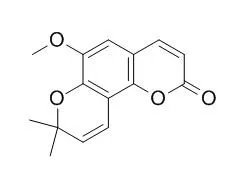| Description: |
Braylin has anti-inflammatory, antinociceptive and immunomodulatory effects, which possibly act through the glucocorticoid receptor activation and by inhibition of the transcriptional activity of NF-κB. Braylin is also a phosphodiesterase-4 inhibitor, it could represent an ideal prototype of glucocorticoid receptor ligand, able to induce synergic immunomodulatory effects. |
| Targets: |
IL Receptor | TNF-α | IFN-γ | NF-kB | TGF-β/Smad |
| In vitro: |
| Adv Pharmacol Sci. 2014;2014:847574. | | Comparative Evaluation of Cytotoxic and Apoptogenic Effects of Several Coumarins on Human Cancer Cell Lines: Osthole Induces Apoptosis in p53-Deficient H1299 Cells.[Pubmed: 25276123] | Natural products are excellent resources for finding lead structures for the development of chemotherapeutic agents. Coumarins are a class of natural compounds found in a variety of plants.
METHODS AND RESULTS:
In this study, we evaluated the cytotoxic potential of coumarins isolated from Prangos ferulacea (L.) Lindl. in PC3, SKNMC, and H1299 (p53 null) human carcinoma cell lines. Osthole proved to be an outstanding potent cytotoxic agent especially against PC3 cells. Isoimperatorin exhibited moderate inhibitory effect against SKNMC and PC3 cell lines. Oxypeucedanin and Braylin did not display any cytotoxic activity. In the next set of experiments, the apoptotic potentials of osthole and isoimperatorin were investigated. Induction of apoptosis by isoimperatorin was accompanied by an increase in activation of caspase-3, -8, and -9 in SKNMC cells and caspase-3 and -9 in PC3 cells. Moreover, isoimperatorin induced apoptosis by upregulating Bax and Smac/DIABLO genes in PC3 and SKNMC cells. Osthole induced apoptosis by downregulating antiapoptotic Bcl-2 in only PC3 cells and upregulating the proapoptotic genes Bax and Smac/DIABLO in PC3, SKNMC, and H1299 cells.
CONCLUSIONS:
The effects of osthole on H1299 cells are important because the loss of p53 has been associated with poor clinical prognosis in cancer treatment. |
|
| In vivo: |
| PLoS One. 2017 Jun 8;12(6):e0179174. | | The anti-inflammatory and immunomodulatory potential of braylin: Pharmacological properties and mechanisms by in silico, in vitro and in vivo approaches.[Pubmed: 28594906 ] | Braylin belongs to the group of natural coumarins, a group of compounds with a wide range of pharmacological properties. Here we characterized the pharmacological properties of Braylin in vitro, in silico and in vivo in models of inflammatory/immune responses.
METHODS AND RESULTS:
In in vitro assays, Braylin exhibited concentration-dependent suppressive activity on activated macrophages. Braylin (10-40 μM) reduced the production of nitrite, IL-1β, TNF-α and IL-6 by J774 cells or peritoneal exudate macrophages stimulated with LPS and IFN-γ. Molecular docking calculations suggested that Braylin present an interaction pose to act as a glucocorticoid receptor ligand. Corroborating this idea, the inhibitory effect of Braylin on macrophages was prevented by RU486, a glucocorticoid receptor antagonist. Furthermore, treatment with Braylin strongly reduced the NF-κB-dependent transcriptional activity on RAW 264.7 cells. Using the complete Freund's adjuvant (CFA)-induced paw inflammation model in mice, the pharmacological properties of Braylin were demonstrated in vivo. Braylin (12.5-100 mg/kg) produced dose-related antinociceptive and antiedematogenic effects on CFA model. Braylin did not produce antinociception on the tail flick and hot plate tests in mice, suggesting that Braylin-induced antinociception is not a centrally-mediated action. Braylin exhibited immunomodulatory properties on the CFA model, inhibiting the production of pro-inflammatory cytokines IL-1β, TNF-α and IL-6, while increased the anti-inflammatory cytokine TGF-β.
CONCLUSIONS:
Our results show, for the first time, anti-inflammatory, antinociceptive and immunomodulatory effects of Braylin, which possibly act through the glucocorticoid receptor activation and by inhibition of the transcriptional activity of NF-κB. Because Braylin is a phosphodiesterase-4 inhibitor, this coumarin could represent an ideal prototype of glucocorticoid receptor ligand, able to induce synergic immunomodulatory effects. |
|






 Cell. 2018 Jan 11;172(1-2):249-261.e12. doi: 10.1016/j.cell.2017.12.019.IF=36.216(2019)
Cell. 2018 Jan 11;172(1-2):249-261.e12. doi: 10.1016/j.cell.2017.12.019.IF=36.216(2019) Cell Metab. 2020 Mar 3;31(3):534-548.e5. doi: 10.1016/j.cmet.2020.01.002.IF=22.415(2019)
Cell Metab. 2020 Mar 3;31(3):534-548.e5. doi: 10.1016/j.cmet.2020.01.002.IF=22.415(2019) Mol Cell. 2017 Nov 16;68(4):673-685.e6. doi: 10.1016/j.molcel.2017.10.022.IF=14.548(2019)
Mol Cell. 2017 Nov 16;68(4):673-685.e6. doi: 10.1016/j.molcel.2017.10.022.IF=14.548(2019)